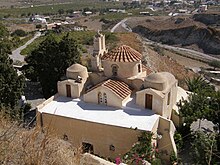Panagia Episkopi
| Panagia Episkopi (Παναγία Επισκοπή) | |
|---|---|

West side of the church
|
|
| Basic information | |
| Location | Mesa Gonia, Santorini |
| Geographic coordinates | 36°22′39″N 25°27′51″E / 36.37750°N 25.46417°ECoordinates: 36°22′39″N 25°27′51″E / 36.37750°N 25.46417°E |
| Year consecrated | 11th to 12th Century |
The Panagia Episkopi (Greek: Παναγία Επισκοπή) is the previous middle-Byzantine cathedral of the Greek Cycladean island of Santorini (Thira). It is also called Panagia tis Episkopis (Παναγία της Επισκοπής) or Church of Episkopi Thiras (Ναός Επισκοπής Θήρας). According to a traditional, now almost completely destroyed inscription, the church building was commissioned by the Byzantine Emperor Alexios I Komnenos at the end of the 11th century, and took the place of a previous three-aisled early Byzantine basilica. The church was dedicated to the Panagia ("All-holy"), a Greek Orthodox appellation for the Virgin Mary. The second part of the name (Episkopi) means "episcopal". The Panagia Episkopi was the seat of the Orthodox diocese of Santorini until 1207 and from 1537 to 1827.
The church was built in the northern foothills of the Profitis Ilias (Προφήτης Ηλίας), the highest mountain on Santorini. It is approximately 600 metres southeast of the township of Mesa Gonia (Μέσα Γωνιά), which is also referred to as Episkopi Gonias (Επισκοπή Γωνιάς), the name of the previous Episcopal seat. The eastern coast of the island at Kamari (Καμάρι) is approximately two kilometres from the church, and Fira (Φηρά), the capital of the island, is five kilometres to the northwest. Mesa Gonia is connected to the Panagia Episkopi via a partially paved road, which ends in a parking area directly north of the church.
The Panagia Episkopi is a beige-washed cross-in-square domed church with peripheral structures. The floor plan takes the shape of a Greek cross with a length of 14 m and breadth of 11.1 m, and the crossing supports a dome upon a tholobate. The roofs of the church are covered with red tiles or simply plastered. The building has five entrances, two each to the north and the south, and a main entrance to the west.
...
Wikipedia
